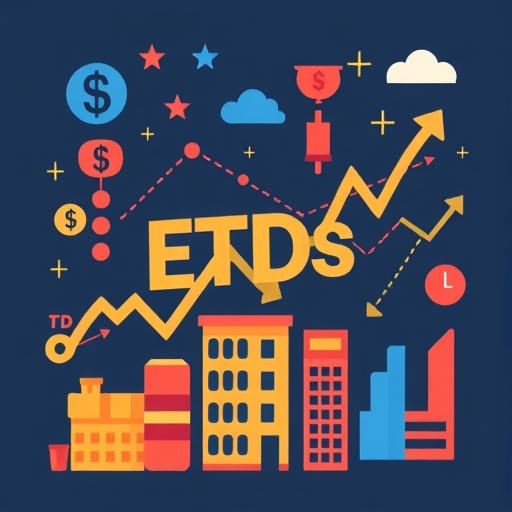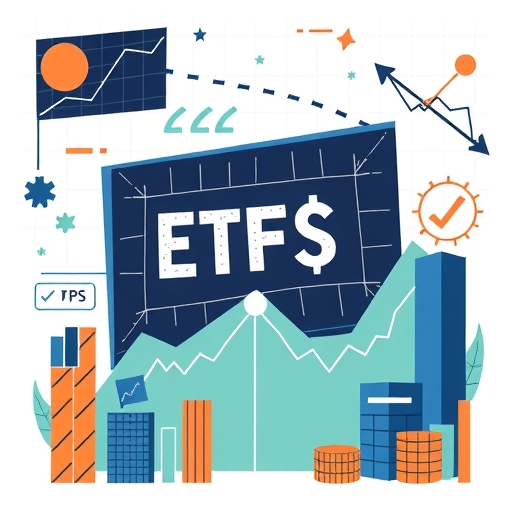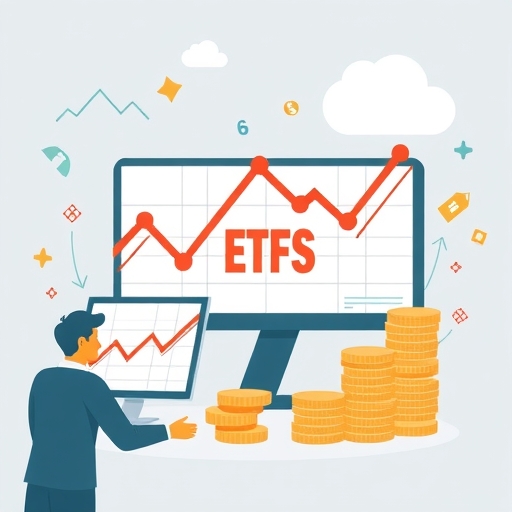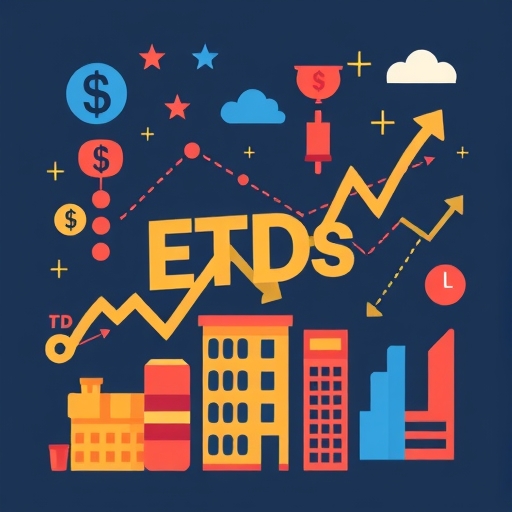ETFs Unveiled: Your Essential Guide to Navigating 2024’s Top Investment Opportunities
Are you looking to enhance your investment portfolio, gain diverse market exposure, and simplify your financial journey without the complexities of picking individual stocks? In an investment world increasingly shaped by dynamic markets and evolving global themes, Exchange Traded Funds (ETFs) have emerged as indispensable tools for investors like you. Offering unparalleled diversification and access to diverse asset classes, ETFs are at the forefront of modern portfolio construction.  As we navigate through economic shifts, including macroeconomic volatility and changing interest rate expectations, understanding the power of ETFs and where to find high-value opportunities becomes paramount for long-term financial success.
As we navigate through economic shifts, including macroeconomic volatility and changing interest rate expectations, understanding the power of ETFs and where to find high-value opportunities becomes paramount for long-term financial success.
In this comprehensive guide, we will explore the strategic advantages of ETFs, dive into the exciting world of thematic investing, and show you how to build a resilient portfolio with diversified and quality-focused options. We’ll also help you understand the broader macroeconomic landscape influencing ETF growth and point you towards essential resources for making informed investment decisions. Let’s unlock the potential of ETFs together.
The Strategic Advantage of ETFs in Volatile Markets
What exactly is an Exchange Traded Fund (ETF)? Simply put, an ETF is a type of investment fund that holds a collection of assets, such as stocks, bonds, or commodities, and trades on stock exchanges, much like individual stocks. Unlike traditional mutual funds, ETFs can be bought and sold throughout the day at market prices. This flexibility, combined with their inherent ability to provide instant diversification, makes them a powerful tool, especially when markets are unpredictable or volatile. 
Consider the current investment climate. We’re seeing increased macroeconomic volatility, influenced by shifts in global trade and interest rate expectations. In such an environment, trying to pick winning individual stocks can feel like searching for a needle in a haystack. ETFs offer a brilliant alternative. By investing in a single ETF, you gain exposure to dozens, hundreds, or even thousands of underlying assets. For example, if you believe in the overall growth of the Australian market, an ETF tracking the ASX 200 index provides broad exposure without requiring you to research and buy 200 different companies individually. This not only simplifies your investment process but also spreads your risk across many different companies or sectors, reducing the impact if any single asset performs poorly.  This is the essence of smart diversification.
This is the essence of smart diversification.
The global appeal of ETFs is undeniable. Projections indicate that global ETF assets are set to reach a staggering $14 trillion by the end of 2024, with further growth anticipated to hit $15-18 trillion by mid-2027.  This robust growth is driven by strong bullish sentiment, particularly in bond markets, where investors show the highest optimism since the Global Financial Crisis, with bond ETFs attracting a significant 43% of all ETF flows. This highlights a clear trend: more and more investors are recognizing the utility and efficiency of ETFs for their portfolios, whether they’re seeking equity growth or fixed-income stability.
This robust growth is driven by strong bullish sentiment, particularly in bond markets, where investors show the highest optimism since the Global Financial Crisis, with bond ETFs attracting a significant 43% of all ETF flows. This highlights a clear trend: more and more investors are recognizing the utility and efficiency of ETFs for their portfolios, whether they’re seeking equity growth or fixed-income stability.
To summarize some key benefits of ETFs:
| Benefit | Description |
|---|---|
| Diversification | Spreads your investment across many assets, reducing risk compared to single stocks. |
| Accessibility | Easy to buy and sell on stock exchanges, just like regular shares. |
| Cost-Effective | Often have lower fees than actively managed mutual funds. |
| Transparency | Holdings are typically disclosed daily, so you know what you own. |
| Thematic Exposure | Allows investment in specific industry trends (e.g., AI, crypto) without picking individual companies. |
ETFs are versatile investment vehicles, suitable for a range of financial goals. They offer specific advantages that cater to different investor needs.
| ETF Type | Primary Focus | Example Use Case |
|---|---|---|
| Equity ETFs | Stocks, targeting specific sectors, countries, or market caps. | Gaining broad exposure to the S&P 500 or Australian tech companies. |
| Bond ETFs | Fixed-income securities (government, corporate bonds). | Seeking income generation or portfolio stability. |
| Commodity ETFs | Physical commodities (gold, oil) or commodity-related assets. | Hedging against inflation or diversifying beyond traditional stocks/bonds. |
| Currency ETFs | Foreign exchange rates. | Speculating on currency movements or hedging currency risk. |
Common uses of ETFs in an investment portfolio often include:
- Building a core portfolio foundation with broad market exposure.
- Gaining targeted exposure to specific industries, countries, or asset classes.
- Implementing tactical shifts in response to market conditions.
Tapping into Megatrends: Thematic ETFs for Future Growth
One of the most exciting aspects of modern investing is the ability to invest directly in the major trends shaping our future. These are often called “megatrends”, and thematic ETFs are designed to give you direct exposure to them. Instead of trying to guess which individual company will lead in a specific innovative sector, you can invest in a basket of companies positioned to benefit from that overarching trend. This approach allows you to capture the long-term growth potential of transformative technologies and societal shifts.
Let’s look at some prominent thematic growth ETFs that are capturing investor interest:
- Betashares Crypto Innovators ETF (ASX: CRYP): This ETF provides exposure to companies that are building the very infrastructure of the crypto economy. Think companies like Coinbase, major cryptocurrency miners, and businesses involved in blockchain technology. If you see the long-term potential in digital assets like Bitcoin, but prefer not to own them directly, CRYP offers a way to invest in the underlying industry growth.
- Betashares Global Robotics and Artificial Intelligence ETF (ASX: RBTZ): Artificial Intelligence (AI) and robotics are transforming industries globally. RBTZ invests in leaders in this space, such as Nvidia and Intuitive Surgical, anticipating massive revenue opportunities as AI becomes more integrated into our daily lives and industries.
- Betashares Cloud Computing ETF (ASX: CLDD): Cloud computing is no longer just a buzzword; it’s a fundamental technology powering everything from streaming services to business operations. CLDD offers exposure to leading cloud service providers and related companies, tapping into this essential and growing technological trend.
- Betashares Global Cybersecurity ETF (ASX: HACK): As our lives become increasingly digital, so do the threats. Cybersecurity spending is soaring as companies and individuals seek to protect their data. HACK invests in global cybersecurity leaders, positioning investors to benefit from the continuous need for digital security.
- Betashares Nasdaq 100 ETF (ASX: NDQ): While not strictly thematic, NDQ provides exposure to the 100 largest non-financial companies listed on the Nasdaq. Many of these are global leaders in AI, cloud computing, e-commerce, and digital infrastructure – essentially, the giants of the digital age. Investing in NDQ means you’re investing in the companies driving much of the world’s technological innovation.
These ETFs allow you to participate in the growth of these powerful trends without the need for extensive individual company research. They represent a strategic way to position your portfolio for future growth driven by innovation.
When considering thematic ETFs, it is important to understand their unique characteristics compared to broader market ETFs. While offering targeted growth, they may also carry specific considerations for investors.
| Characteristic | Thematic ETFs | Broad Market ETFs |
|---|---|---|
| Focus | Niche industries or specific megatrends (e.g., AI, clean energy). | Entire markets or large segments (e.g., S&P 500, global equities). |
| Diversification | Often less diversified, concentrated in a specific theme. | Highly diversified across many sectors and companies. |
| Growth Potential | Potentially higher if the theme performs strongly. | Generally aligns with overall market growth. |
| Risk | Higher concentration risk; dependent on the success of a single theme. | Lower individual company/sector risk due to broad exposure. |
| Research Needs | Requires understanding of the specific theme’s long-term viability. | Focus on overall market conditions and economic outlook. |
While thematic ETFs offer exciting opportunities, investors should be aware of potential risks inherent to their focused nature:
- **Concentration Risk:** Being focused on a single theme means performance is highly dependent on that theme’s success, which can lead to higher volatility.
- **Fad vs. Trend:** It can be challenging to distinguish between a long-term megatrend and a short-lived fad, leading to potential overvaluation or quick declines.
- **Overlap with Core Holdings:** Some thematic ETFs might have significant overlap with companies already held in broader market ETFs, reducing true diversification benefits.
Building a Resilient Portfolio: Diversified and Quality-Focused ETF Options
While thematic ETFs offer exciting growth potential, a well-rounded and resilient portfolio also requires broad diversification and a focus on fundamental quality. This means including investments that spread risk across different markets and asset classes, and prioritizing companies with strong financial health and sustainable competitive advantages. Let’s explore some ETFs that help achieve this stability and quality:
- Betashares Australian Quality ETF (ASX: AQLT): This ETF focuses on Australian shares that exhibit “quality” characteristics. What does quality mean in this context? It means companies with strong balance sheets, low debt levels, and stable earnings. AQLT aims to provide a more refined exposure to the Australian market, resembling a “best-of-the-best” version of the ASX 200, designed for long-term stability and growth.
- Betashares Diversified All Growth ETF (ASX: DHHF): For investors seeking an all-in-one, hands-off growth solution, DHHF is an excellent choice. It provides broad exposure to global and Australian equities and is automatically rebalanced. This means you get a diversified portfolio that is maintained for you, designed to capture long-term equity market returns without the hassle of managing multiple funds or individual stocks.
- Vanguard MSCI Index International Shares ETF (ASX: VGS): If you want truly broad international diversification, VGS is a popular option. It invests in approximately 1,200 large and mid-cap companies across developed markets like the US, Japan, the UK, and Europe. This ETF ensures your portfolio isn’t overly reliant on any single country, offering a wide net across the global economy.
- VanEck Morningstar Wide Moat ETF (ASX: MOAT): Inspired by legendary investor Warren Buffett’s philosophy, MOAT focuses on fairly valued stocks that possess “wide moats.” A wide moat refers to a sustainable competitive advantage that protects a company’s long-term profitability and market share. This could be anything from strong brand recognition, patent protection, or cost advantages. Investing in companies with wide moats is a strategy aimed at long-term, compounding returns, as these businesses are better positioned to weather economic downturns and maintain their pricing power.
Recently, new options have also emerged, such as the Betashares Australian Shares High Yield ETF (ASX: HYLD), which focuses on providing income through high-dividend-paying Australian shares. Including a mix of these diversified and quality-focused ETFs can help you build a robust foundation for your investment portfolio, providing both stability and growth potential.
Navigating the Macro Landscape: ETF Growth Drivers and Market Outlook
Understanding the broader macroeconomic picture is crucial for any investor, as it significantly influences market trends and the performance of various asset classes, including ETFs. What are the key forces shaping the investment landscape right now? We’re seeing some significant shifts that are impacting where investment dollars are flowing.
Firstly, the sheer growth of ETFs is a testament to their utility. As mentioned, global ETF assets are set to reach $14 trillion by the end of 2024. This growth isn’t just about equities; there’s a notable bullish sentiment towards bonds, the highest since the Global Financial Crisis. Investors are increasingly favoring bonds over cash, with bond ETFs alone attracting 43% of all ETF flows. This suggests a search for stability and potentially attractive yields in a changing interest rate environment.
Secondly, the demand for active ETFs is surging. Active ETFs, unlike passive index-tracking ETFs, are managed by a fund manager who actively selects investments with the aim of outperforming a benchmark. In 2023, these funds experienced significant growth, especially in the U.S., and survey respondents anticipate “significant” demand for active ETFs in the next 2-3 years. This trend suggests that investors are increasingly valuing expert management to navigate anticipated macroeconomic volatility, especially with the “duration trade reversal” influencing equity and bond markets in 2024.
To effectively navigate the market, it is essential for investors to monitor several key economic indicators that can influence ETF performance and market sentiment:
- **Inflation Rates:** Rising inflation can erode purchasing power and impact corporate earnings, influencing central bank policies.
- **Interest Rates:** Changes in central bank interest rates directly affect bond yields and can influence borrowing costs for companies, impacting stock valuations.
- **Employment Data:** Unemployment rates and job growth figures provide insights into economic health and consumer spending, which are crucial for equity markets.
Thirdly, we need to consider inflation and interest rates. Global inflation has decreased, and equity markets are already pricing in interest rate cuts for 2024. The focus is now on potential “economic landing scenarios” – whether the economy will achieve a soft landing, avoid a recession, or face a harder downturn. Concerns persist regarding a potential softening labor market and recession risks in the US and Europe. These factors will undoubtedly influence corporate earnings and investor sentiment, making it vital to stay informed and potentially adjust your portfolio strategy. For instance, the U.S. achieving net energy exporter status in 2019 has long-term implications for the energy sector, shifting global dynamics and investment opportunities within commodities like oil and gas.
In essence, the market is dynamic. While thematic investing in areas like AI and cybersecurity continues to offer long-term opportunities, paying attention to broader economic signals, such as bond market shifts and central bank policies, will help you make more informed decisions about your overall portfolio allocation.
Essential Resources for Informed ETF Investing
In the vast and ever-evolving world of ETFs, having access to reliable information is key to making sound investment decisions. You might be wondering, “Where can I find trustworthy data, analysis, and expert insights to guide my ETF choices?” Fortunately, there are many excellent resources available, catering to various levels of expertise.
We recommend exploring a combination of leading ETF blogs, websites, and industry events to stay updated and deepen your knowledge. Here’s a brief overview of what some of these platforms typically offer:
- Real-time Data and Quotes: Websites like Investing.com, ETF.com, and NASDAQ provide live market data, ETF prices, and historical charts, allowing you to track performance.
- Financial Tools: Many platforms offer powerful tools such as ETF screeners (to filter ETFs by criteria like sector, region, or expense ratio), comparison tools, and portfolio analyzers. ETF Database and Morningstar are particularly strong in this area.
- News and Analysis: For daily updates, market commentary, and in-depth articles, sources like ETF Daily News, ETF Trends, Seeking Alpha, Benzinga, and The Motley Fool are invaluable. They often feature expert opinions and breakdowns of current market events.
- Investment Guides and Education: If you’re looking to understand fundamental concepts or specific ETF strategies, platforms like Fidelity Investments and Vanguard’s educational sections, along with specialized blogs like Canadian Couch Potato and ETF Monkey, provide comprehensive guides.
- Expert Commentary and Insights: For deeper dives and strategic perspectives, look for analysis from firms like VanEck, WisdomTree, and Invesco, which often publish their own market outlooks and research.
Beyond online resources, industry events can be incredibly insightful. Conferences such as “Exchange: An ETF Experience” bring together financial advisors, industry leaders, and experts to discuss wealth management, market trends, and foster community within the ETF sector. Attending such events, or even following their summaries, can provide a high-level view of the latest developments and strategic thinking in the ETF space.
By regularly engaging with these resources, you can build a strong foundation of knowledge, identify new opportunities, and refine your investment strategy, ensuring your ETF portfolio remains aligned with your financial goals.
Conclusion: Empowering Your Investment Journey with ETFs
As we’ve explored, Exchange Traded Funds (ETFs) continue to redefine investment accessibility and strategy, offering a versatile solution for both novice and seasoned investors. Their ability to simplify diversification, capture global growth themes, and adapt to evolving market conditions positions them as a cornerstone of future financial planning. Whether you’re interested in the cutting edge of Artificial Intelligence, the stability of quality-focused equities, or the evolving landscape of bonds, there’s likely an ETF suited to your investment goals.
By staying informed about market trends, understanding the implications of macroeconomic shifts like inflation and interest rates, and leveraging reliable research resources, you can confidently harness the power of ETFs to build resilient, growth-oriented portfolios for the long term. Remember, the journey to financial success is continuous learning and adaptation.
Frequently Asked Questions (FAQ)
Q: What is the main difference between an ETF and a traditional mutual fund?
A: The primary difference is how they are traded. ETFs trade like stocks on an exchange throughout the day at market prices, offering greater flexibility. Mutual funds are typically bought and sold once a day at their end-of-day net asset value (NAV).
Q: How do thematic ETFs differ from traditional index ETFs?
A: Thematic ETFs focus on specific long-term trends or industries (e.g., AI, cybersecurity), offering concentrated exposure to potential growth areas. Traditional index ETFs, conversely, aim to track a broad market index like the S&P 500, providing wider diversification across an entire market segment.
Q: Are ETFs suitable for all investors?
A: ETFs offer various benefits like diversification, lower costs, and flexibility, making them suitable for many investors from beginners to experienced traders. However, an investor’s suitability for specific ETFs depends on their individual financial goals, risk tolerance, and investment horizon. It is always recommended to conduct thorough research or consult with a financial advisor.
Disclaimer: This article is for informational and educational purposes only and does not constitute financial advice. Investing in any financial instrument carries risks, and past performance is not indicative of future results. We recommend consulting with a qualified financial advisor before making any investment decisions.



No responses yet